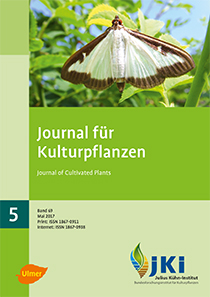Mapping of the <em>Rpv</em> Resistance Gene against Downy Mildew in Pea (<em>Pisum sativum</em> L.)
DOI:
https://doi.org/10.5073/JfK.2017.05.02Keywords:
Pisum sativum L., resistance gene, Rpv, downy mildew, Peronospora viciae, genetic linkage map, flanking markersAbstract
Downy mildew causes severe yield and quality losses in pea (Pisum sativum L.). Therefore, the development of downy mildew resistant varieties is of high priority for pea breeders. Within this study in total 335 F3 families from a cross of the highly susceptible green pea variety `Topaz´ with the resistant breeding line `Gen. 27´ were tested for resistance behaviour against Peronospora viciae f. sp. pisi to determine the genotype of the corresponding F2 parental plants. The ratio 94:161:80 for homozygous resistant, heterozygous resistant and homozygous susceptible F2 plants was not significantly different from 1:2:1, expected for the effect of a single dominant resistance gene. The resistance gene Rpv was mapped to linkage group 1 of the pea genetic map. This linkage group was saturated by molecular markers available from literature. The marker AD147 was identified as nearest proximal flanking marker with 4.4 cM distance, and in distal position marker AB28 with 18.8 cM distance. Further marker saturation using the syntenic relationship of P. sativum and Medicago truncatula was not effective. The usefulness of the identified markers for marker assisted selection has been confirmed in independent pea breeding material and the results of this study should lay the basis for future fine mapping studies.
Published
Issue
Section
License
The content of the journal is licensed under the Creative Commons Attribution 4.0 License. Any user is free to share and adapt (remix, transform, build upon) the content as long as the original publication is attributed (authors, title, year, journal, issue, pages).
The copyright of the published work remains with the authors. The authors grant the Journal of Cultivated Plants, the Julius Kühn-Institut and the OpenAgrar repository the non-exclusive right to distribute and exploit the work.







